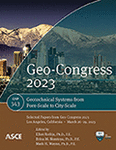Bioremediation of Desiccation Cracking in Clayey Soils Using Enzyme Induced Calcite Precipitation
Publication: Geo-Congress 2023
ABSTRACT
Desiccation cracking in expansive soils is critical to their hydraulic and mechanical properties and affects the long-term performance of various geotechnical infrastructure. In recent years, bio-mediated methods such as bio-cementation have been explored as a possible approach for ground improvement. This study explores the potential of using Enzyme Induced Calcite Precipitation (EICP) for desiccation cracking remediation in clayey soils. EICP uses biologically derived material (plant-based urease enzyme) without requiring bacteria incubation. In this study, crude extract from soybean (Glycine max) is used for urea hydrolysis. Three different enzyme concentrations (10, 30, and 50 g/L) are used to evaluate the effect of calcite precipitation on desiccation crack. According to the analysis of soil cracking images, this technique significantly induces calcite precipitations and effectively reduces the extent of desiccation cracking in clayey soils. The EICP-treated sample demonstrated that the crack area, crack width, and crack length decrease for the higher concentration of urease enzyme with the increasing W–D cycle. The lower concentrations (10 g/L) have minor effects on crack remediation but effectively limit the growth of new cracks. Moreover, when the enzyme concentration increases, calcium carbonate precipitations tend to form a crust on the soil surface, gradually increasing soil surface roughness. This study is expected to improve the fundamental understanding of the EICP technique and provide new insights into its potential application for soil improvement.
Get full access to this article
View all available purchase options and get full access to this chapter.
REFERENCES
Ahenkorah, I., Rahman, M. M., Karim, M. R., and Teasdale, P. R. (2020). Optimization of Enzyme Induced Carbonate Precipitation (EICP) as a Ground Improvement Technique. Geo-Congress 2020, 552–561.
Almajed, A., Khodadadi Tirkolaei, H., and Kavazanjian, E. (2018). Baseline Investigation on Enzyme-Induced Calcium Carbonate Precipitation. Journal of Geotechnical and Geoenvironmental Engineering, 144(11), 04018081.
Cheng, Q., Tang, C.-S., Xu, D., Zeng, H., and Shi, B. (2021). Water infiltration in a cracked soil considering effect of drying-wetting cycles. Journal of Hydrology, 593, 125640.
Dilrukshi, R. A. N., Nakashima, K., and Kawasaki, S. (2018). Soil improvement using plant-derived urease-induced calcium carbonate precipitation. Soils and Foundations, 58(4), 894–910.
Dong, Y., and Lu, N. (2017). Measurement of Suction Stress Characteristic Curve under Drying and Wetting Conditions. Geotechnical Testing Journal 40 (1), 107–121.
Harianto, T., Hayashi, S., Du, Y.-J., and Suetsugu, D. (2008). Effects of Fiber Additives on the Desiccation Crack Behavior of the Compacted Akaboku Soil as A Material for Landfill Cover Barrier. Water, Air, and Soil Pollution, 194(1–4), 141–149.
Javadi, N., Khodadadi Tirkolaei, H., Hamdan, N., and Kavazanjian, E. (2021). Longevity of Raw and Lyophilized Crude Urease Extracts. Sustainable Chemistry, 2(2), 325–334.
Liu, B., Zhu, C., Tang, C.-S., Xie, Y.-H., Yin, L.-Y., Cheng, Q., and Shi, B. (2020). Bio-remediation of desiccation cracking in clayey soils through microbially induced calcite precipitation (MICP). Engineering Geology, 264, 105389.
Martin, K., Tirkolaei, H. K., and Kavazanjian, E. (2021). Enhancing the strength of granular material with a modified enzyme-induced carbonate precipitation (EICP) treatment solution. Construction and Building Materials, 271, 121529.
Omidi, G. H., Prasad, T. V., Thomas, J. C., and Brown, K. W. (1996). The influence of amendments on the volumetric shrinkage and integrity of compacted clay soils used in landfill liners. Water, Air, and Soil Pollution, 86(1–4), 263–274.
Reddy, N. G., Tahasildar, J., and Rao, B. H. (2015). Evaluating the Influence of Additives on Swelling Characteristics of Expansive Soils. International Journal of Geosynthetics and Ground Engineering, 1(1), 7.
Tang, C., Shi, B., Liu, C., Zhao, L., and Wang, B. (2008). Influencing factors of geometrical structure of surface shrinkage cracks in clayey soils. Engineering Geology, 101(3–4), 204–217.
Tang, C. S., Shi, B., Cui, Y.-J., Liu, C., and Gu, K. (2012). Desiccation cracking behavior of polypropylene fiber–reinforced clayey soil. Canadian Geotechnical Journal, 49(9), 1088–1101.
Vail, M., Zhu, C., Tang, C.-S., Maute, N., and Montalbo-Lomboy, M. T. (2020). Desiccation Cracking Behavior of Clayey Soils Treated with Biocement and Bottom Ash Admixture during Wetting–Drying Cycles. Transportation Research Record: Journal of the Transportation Research Board, 2674(8), 441–454.
Zhuo, Z., Zhu, C., Tang, C.-S., Xu, H., Shi, X., and Mark, V. (2022). 3D characterization of desiccation cracking in clayey soils using a structured light scanner. Engineering Geology, 299, 106566.
Information & Authors
Information
Published In
History
Published online: Mar 23, 2023
Authors
Metrics & Citations
Metrics
Citations
Download citation
If you have the appropriate software installed, you can download article citation data to the citation manager of your choice. Simply select your manager software from the list below and click Download.
